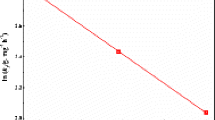Abstract
The starch-based material, ethylenediamine modified cross-linked starch (CAS) was synthesized and employed to remove hexavalent chromium from aqueous solution. Maximum adsorption of total chromium was observed at reaction pH of 4.0 and adsorption equilibrium achieved within 4h. The adsorption process can be described by pseudo-second-order adsorption model and the best-fit isotherm is Freudlich equation. The mechanism is predominately based on electrostatic attraction. The FT-IR spectra indicate that the amino groups of CAS are protonated and the hexavalent chromium ions were effectively adsorbed. Furthermore, studies on chromium release by using inorganic electrolytes confirm the mechanism observed by sorption experiments, which HCrO4 − ion plays an important role interacting with CAS. Chromium release increases with increasing negative charge of electrolyte following the sequence PO4 3− > SO4 2− > B4O7 2− > NO3 −.









Similar content being viewed by others
References
Crini G (2005) Prog Polym Sci 30:38–70 10.1016/j.progpolymsci.2004.11.002
Aly AA (2006) Starch/Stäke 58:391–400
Yin QF, Ju BZ, Zhang SF, Wang XB, Yang JZ (2008) Carbohydr Polym 72:326–333 10.1016/j.carbpol.2007.08.019
Xiang B, Li YJ, Ni YM (2004) J Appl Polym Sci 92:3881–3885 10.1002/app.20415
Guo L, Zhang SF, Ju BZ, Yang JZ, Quan X (2006) J Polym Res 13:213–217 10.1007/s10965-005-9028-4
Cao LQ, Xu SM, Feng S, Peng G, Wang JD (2004) J Polym Res 11:105–108 10.1023/B:JPOL.0000031066.67853.28
Kowalski Z (1994) J Hazard Mater 37:137–144 10.1016/0304-3894(94)85042-9
Dupont L, Guillon E (2003) Environ Sci Technol 37:4235–4241 10.1021/es0342345
Pollard SJT, Fowler GD, Sollars CJ, Perry R (1992) Sci Total Environ 116:31–52 10.1016/0048-9697(92)90363-W
Nakano Y, Takeshita K, Tsutsumi T (2001) Water Res 35:496–500 10.1016/S0043-1354(00)00279-7
Kaminski W, Tomczak E, Jaros K (2008) Desalination 218:281–286 10.1016/j.desal.2007.02.023
Yiğitoğlu M, Arslan M (2005) Polym Bull 55:259–268 10.1007/s00289-005-0440-z
Fritzen MB, Souza AJ, Silva TAG, Souza L, Nome RA, Fiedler HD, Nome F (2006) J Colloid Interface Sci 296:465–471 10.1016/j.jcis.2005.09.037
Nakajima A, Baba Y (2004) Water Res 38:2859–2864 10.1016/j.watres.2004.04.005
Ho YS, McKay G (2000) Water Res 34:735–742 10.1016/S0043-1354(99)00232-8
Kumar PA, Chakraborty S, Ray M (2008) Chem Eng J 141:130–140 10.1016/j.cej.2007.11.004
Bayramoğlu G, Arıca MY (2005) Separ Purif Tech 45:192–199 10.1016/j.seppur.2005.03.009
Langmuir I (1918) J Am Chem Soc 40:1361–1401 10.1021/ja02242a004
Giles CH, Smith D, Huitson A (1974) J Colloid Interface Sci 47:755–765 10.1016/0021-9797(74)90252-5
Hinz C (2001) Geoderma 99:225–243 10.1016/S0016-7061(00)00071-9
Freundlich HMF (1906) Z Phys Chem 57:385–470
Reddad Z, Gérente C, Andrès Y, Ralet MC, Thibault JF, Le Cloirec P (2002) Carbohydr Polym 49:23–31 10.1016/S0144-8617(01)00301-0
Vongchan P, Sajomsang W, Subye D, Kongtawelert P (2002) Carbohydr Res 337:1233–1236 10.1016/S0008-6215(02)00098-8
Li J, Qi T, Wang L, Liu C, Zhang Y (2007) Mater Lett 61:3197–3200 10.1016/j.matlet.2006.11.079
Kharlampieva E, Sukhishvili SA (2004) Langmuir 20:9677–9685 10.1021/la048763d
Pristinski D, Kozlovskaya V, Sukhishvili SA (2005) J Chem Phys 122:0149071–0149079 10.1063/1.1829255
Acknowledgement
This work is supported by the National Natural Science Foundation of China (No. 20577034) and Shanghai Leading Academic Discipline Project (No. P1304), China.
Author information
Authors and Affiliations
Corresponding author
Rights and permissions
About this article
Cite this article
Cheng, R., Ou, S., Xiang, B. et al. Adsorption behavior of hexavalent chromium on synthesized ethylenediamine modified starch. J Polym Res 16, 703–708 (2009). https://doi.org/10.1007/s10965-009-9276-9
Received:
Accepted:
Published:
Issue Date:
DOI: https://doi.org/10.1007/s10965-009-9276-9




